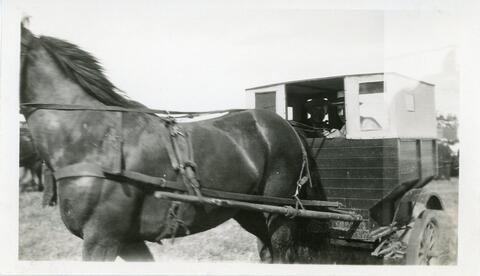
Title and statement of responsibility area
Title proper
Horse and Bennett Buggy in Biggar, Saskatchewan
General material designation
- Graphic material
Parallel title
Other title information
Title statements of responsibility
Title notes
Level of description
Item
Reference code
Edition area
Edition statement
Edition statement of responsibility
Class of material specific details area
Statement of scale (cartographic)
Statement of projection (cartographic)
Statement of coordinates (cartographic)
Statement of scale (architectural)
Issuing jurisdiction and denomination (philatelic)
Dates of creation area
Date(s)
Physical description area
Physical description
1 photograph: b&w; 7 cm x 11.5 cm
Publisher's series area
Title proper of publisher's series
Parallel titles of publisher's series
Other title information of publisher's series
Statement of responsibility relating to publisher's series
Numbering within publisher's series
Note on publisher's series
Archival description area
Name of creator
Custodial history
Scope and content
Two men in a Bennett Buggy with one horse hitched to it
Notes area
Physical condition
Immediate source of acquisition
Arrangement
Language of material
Script of material
Location of originals
Availability of other formats
Restrictions on access
Terms governing use, reproduction, and publication
Copyright: Public Domain
Finding aids
Associated materials
Accruals
General note
A Bennett buggy was a term used in Canada during the Great Depression to describe a car which had its engine and windows taken out and was pulled by a horse. In the United States, such vehicles were known as Hoover carts, named after then-President Herbert Hoover.
The Canadian term was named after Richard Bennett, the Prime Minister of Canada from 1930 to 1935, who was blamed for the nation's poverty. Cars being pulled by horses became a common sight during the Depression. During the boom years of the 1920s, many Canadians had bought cheap vehicles for the first time, but during the depression, many found they did not have enough money to operate them. This was especially true in the hard-hit Prairie Provinces. The increased poverty played an important role, as farmers could not buy gasoline. The price of gas also increased. Gas taxes were also one of the best sources of revenue for the provincial governments. When these provinces went into a deficit, they increased these taxes, making gas even harder to buy.
In Saskatchewan, badly hit by the depression, similar vehicles with an additional seat over the front axle were dubbed "Anderson carts" after Premier James T. M. Anderson.
Alternative identifier(s)
Standard number area
Standard number
Access points
Subject access points
Place access points
Name access points
- Bennet Buggies (Subject)

